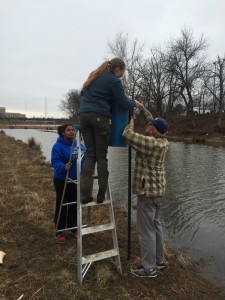With the winter months melting away, migratory waterfowl have begun to race north to secure their nesting habitat for the upcoming breeding season. The Olentangy and Scioto Rivers are important riparian corridors for waterfowl migration within the Mississippi Flyaway. STRIVE lab research assistant, Reina Tyl, has been busy building wood duck (Aix sponsa) boxes to place along the Olentangy and Scioto Rivers as part of the conservation of riparian birds research project. Wood ducks are cavity nesters, meaning that they naturally lay their eggs in hollowed out parts of trees. Where natural tree cavities are not available, wood ducks will nest in man-made boxes built to mimic natural tree cavities.
The wood ducks boxes, constructed from water softener tubes, are filled with an approximately 4″ deep layer of wood shavings to provide nesting material for the wood ducks. Wood ducks, unlike some other birds, do not construct nests or bring material into their nesting cavities.
STRIVE lab members (left to right) Travonya Kenly, Reina Tyl, and Lars Meyer secure a wood duck box to a post. The box opening is facing the Olentangy River, so that passing wood ducks will be able to take notice of the available nest habitat. The boxes are placed so that the openings will face east in order to reduce the amount of rain and wind that will be able to enter the boxes from the west.
STRIVE lab members (left to right) Lars Meyer, Reina Tyl, and Travonya Kenly are all smiles setting up a wood duck box across from the ‘Shoe!
Reina Tyl posing with a newly placed wood duck box in one of the wetlands at the Olentangy River Wetland Research Park.





